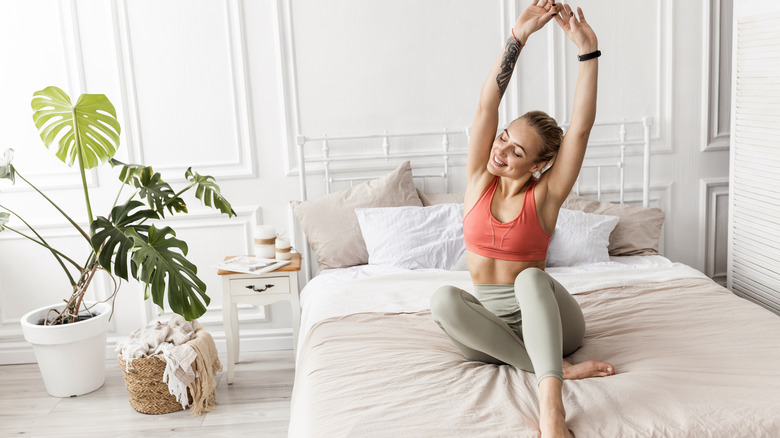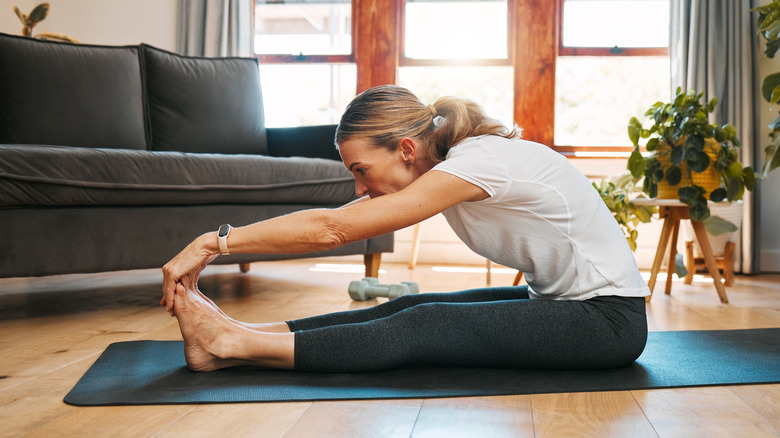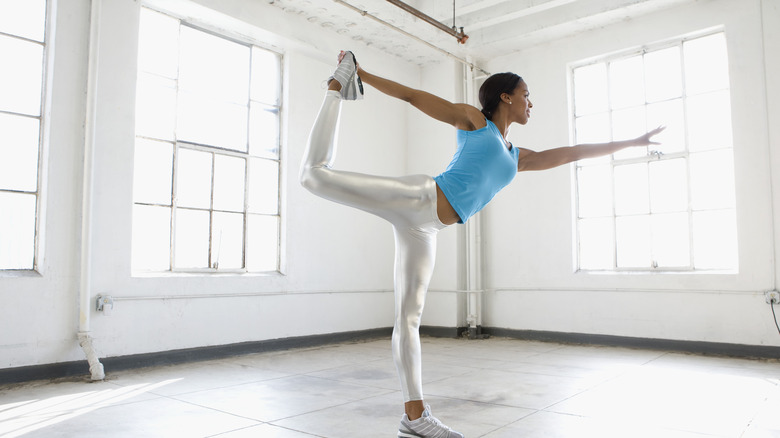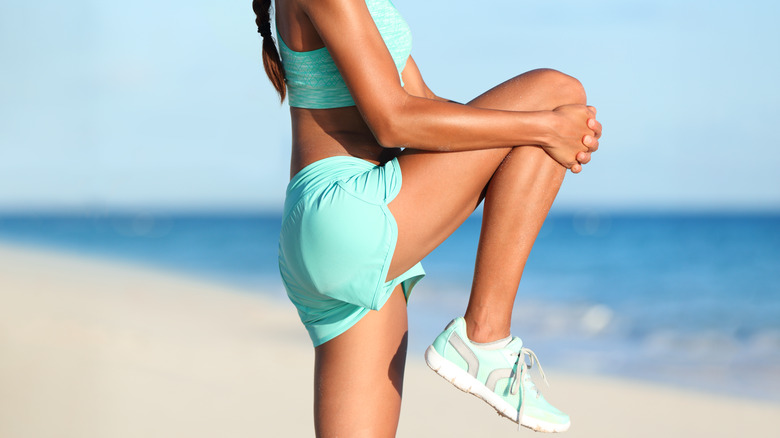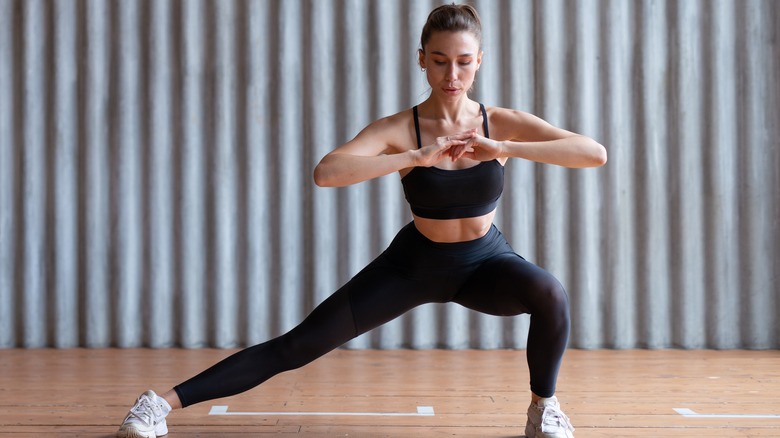The Science Behind Stretching Feeling So Good (& Why You Should Do It More Often)
While you are likely aware of the importance of stretching prior to exercising, stretching should not be solely confined to the gym or looked at as being for athletes only. In fact, experts say that stretching every single day, regardless of age or activity level, is essential in maintaining our flexibility and range of motion as we age. "A lot of people don't understand that stretching has to happen on a regular basis. It should be daily," says David Nolan, a physical therapist at Harvard-affiliated Massachusetts General Hospital (per Harvard Health).
So not only does that full body stretch after getting out of bed in the morning feel great in the moment, but making daily stretching a habit as you age can help you also reap the benefits long term in the form of sustained range of motion and mobility throughout the years. "Our joints can lose up to 50% of their range of motion as we age, so stretching is not just important for athletes hoping to prevent tears, sprains or strains; rather, we all need to be consistent with stretching during each stage in our lives," says celebrity fitness coach Kollins Ezekh (via Forbes).
In addition to aiding in flexibility, stretching offers a number of other health benefits — and understanding them can help motivate you to make it a point to work stretching into your daily routine — plus if you do it correctly, it can provide toe-curlingly good instant gratification.
So what is stretching – and why does it feel so satisfying?
A stretch is simply the act of flexing or lengthening your body to relieve tension in your muscles, tendons, joints, ligaments, and joints. As such, stretching is important, as not regularly relieving the tension in these areas of your body and engaging your muscles can ultimately shorten them and cause them to tighten and weaken, putting you at risk for joint pain, strains, and even muscle damage when it does come time to extend these muscles (per Harvard Medical School).
In addition to helping keep you mobile and active for as much of your life as possible by helping you maintain your flexibility over time, stretching can keep your muscles healthy and properly functioning in the present by forcing you to use the ones that would otherwise go unused — especially if you live an otherwise sedentary lifestyle. "Stretching brings blood flow to muscles that are often underused throughout the day, helping them feel less tense and more relaxed," says Jeff Brannigan, program director at the mobility-focused studio, Stretch*d in New York City (via Well + Good). "This boost in circulation helps revive muscles — almost like rehydrating them with a fresh supply of nutrients." This improvement in circulation releases neurotransmitters such as dopamine and serotonin, which exercise physiologist Sharon Gam, Ph.D., CSCS says "makes the stretch feel good as a way to reinforce the action" per Well + Good.
Stretching can improve posture and relieve pain
It's especially important to focus on maintaining your flexibility through stretching if you live a sedentary lifestyle or work at a desk job that requires you to remain in one position for long periods of time. The issue with limiting yourself to just a few different positions throughout the day is that you place an increased reliance on using just a few body parts — while largely ignoring the rest. This can cause your body to become naturally accustomed to carrying itself like this and to relying on a limited and modified range of motion, which contributes to poor posture.
"When our muscles, bones, and joints aren't in the right place, we have to carry extra tightness in certain areas to accommodate that," says Kate Galliett, a NASM-certified personal trainer and Functional Anatomy Seminars–certified functional range conditioning mobility specialist (via Everyday Health). "A lot of times, the low back can feel really tight because our bodies aren't in an optimal position to support our skeletal structure: our head is a little forward, maybe our rib cage and pelvis are tipped too far forward, and so all our weight is leaning forward."
"When we spend time in suboptimal positions, certain muscles in our body — such as shoulders, back, core, and neck — actually shorten," adds Grayson Wickham, DPT, CSCS, founder of Movement Vault (per Healthline). Stretching can prevent and repair the damage to your muscles caused by shortening from improper or non-use.
Stretching can relieve stress
In addition to benefiting the physical body, stretching is regarded as an excellent stress reliever. Research published in the American Journal of Sports Science Medicine suggests that stretching activates the parasympathetic nervous system while simultaneously inhibiting sympathetic nervous system function, which are, respectively, responsible for helping us feel safe and relaxed and activating our "fight or flight" responses (per Cleveland Clinic).
"Stretching can be a great way to center and prepare yourself physically and mentally before the rush of the day," says physical therapist Nicholas Licameli (via Elite Daily). "Too many times, we neglect the parasympathetic nervous system and therefore, physical and mental rest and recovery. We wake up, jump out of bed, rush to the shower, frantically get dressed, and grab a cup of coffee as we run out the door. Add in a stressful commute, sandwiching a hectic work day, and we can see how it is so easy to neglect rest and recovery."
If you find yourself waking up and already feeling stressed about the busy day ahead of you, Jennifer McCamish, pilates instructor and founder of the fitness studio, Shape Method, suggests setting time aside to stretch before beginning the tasks at hand. "Stretching brings oxygen to the brain and body, which can help wake you up and feel refreshed," she says via Bustle, adding that you can reap the benefits of stretching in as little as 10 minutes — making it easy to work into a busy morning routine or to do while taking a quick break from work in between meetings.
Static versus dynamic stretching
As is true with any level of physical activity, not all stretching is created equal. While each of the two main forms of stretching technically involves movement, static stretching involves moving into an end range of motion, followed by a period of holding that position, says physical therapist and strength coach Ravi Patel, D.P.T., C.S.C.S., (via SELF). Think bending from the waist, touching your toes (or trying to reach them), and counting to 20.
Dynamic stretching differs from static stretching because it has to do with continuous movement in which you don't hold a stretch. Dynamic stretches include things like walking lunges, high kicks, and torso twists.
"Dynamic stretching is great before an activity," adds physical therapist Sarah Kostyukovsky, P.T., DPT, OCS, adding that static stretching is better suited for after your muscles have already warmed up, such as after a run or a gym session (per mbg movement).
How long should you stretch for?
If you aren't used to taking the time to stretch all the muscles in your body every day, then you might be unsure of where and how to start when it comes to making it second nature. Just like beginning any new physical activity, it's important to start slow until you have a better idea of your body's limits. While stretching can sometimes feel uncomfortable — especially if you are consciously working muscles you normally don't think to — it should never hurt. If you feel any pain while stretching, you should immediately stop, as this is usually an indication you aren't doing the stretch right, which has the potential to cause injury.
While there is no "right" amount of time to commit to stretching each day, Mayo Clinic notes that just five to 10 minutes of regular stretching — at least two to three times a week — can be beneficial. If you are stretching prior to working out, Galliett says 10 minutes of dynamic stretching is more than enough, whereas if you are stretching to center yourself and relax, it's best to look at 10 minutes as a minimum.
If you are limited in your range of motion, it's important not to push yourself too far. Luckily, most stretches can be done with modifications. Using the wall to maintain your balance or using another tool such as a yoga block to make the stretches more comfortable for you is a great way to reap the benefits of a stretch without risking injury.
